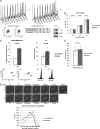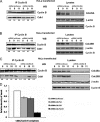Cdc25 phosphatases are required for timely assembly of CDK1-cyclin B at the G2/M transition
- PMID: 20360007
- PMCID: PMC2878026
- DOI: 10.1074/jbc.M109.096552
Cdc25 phosphatases are required for timely assembly of CDK1-cyclin B at the G2/M transition
Abstract
Progression through mitosis requires the coordinated regulation of Cdk1 kinase activity. Activation of Cdk1 is a multistep process comprising binding of Cdk1 to cyclin B, relocation of cyclin-kinase complexes to the nucleus, activating phosphorylation of Cdk1 on Thr(161) by the Cdk-activating kinase (CAK; Cdk7 in metazoans), and removal of inhibitory Thr(14) and Tyr(15) phosphorylations. This dephosphorylation is catalyzed by the dual specific Cdc25 phosphatases, which occur in three isoforms in mammalian cells, Cdc25A, -B, and -C. We find that expression of Cdc25A leads to an accelerated G(2)/M phase transition. In Cdc25A-overexpressing cells, Cdk1 exhibits high kinase activity despite being phosphorylated on Tyr(15). In addition, Tyr(15)-phosphorylated Cdk1 binds more cyclin B in Cdc25A-overexpressing cells compared with control cells. Consistent with this observation, we demonstrate that in human transformed cells, Cdc25A and Cdc25B, but not Cdc25C phosphatases have an effect on timing and efficiency of cyclin-kinase complex formation. Overexpression of Cdc25A or Cdc25B promotes earlier assembly and activation of Cdk1-cyclin B complexes, whereas repression of these phosphatases by short hairpin RNA has a reverse effect, leading to a substantial decrease in amounts of cyclin B-bound Cdk1 in G(2) and mitosis. Importantly, we find that Cdc25A overexpression leads to an activation of Cdk7 and increase in Thr(161) phosphorylation of Cdk1. In conclusion, our data suggest that complex assembly and dephosphorylation of Cdk1 at G(2)/M is tightly coupled and regulated by Cdc25 phosphatases.
Figures







Similar articles
-
Cdc25B cooperates with Cdc25A to induce mitosis but has a unique role in activating cyclin B1-Cdk1 at the centrosome.J Cell Biol. 2005 Oct 10;171(1):35-45. doi: 10.1083/jcb.200503066. J Cell Biol. 2005. PMID: 16216921 Free PMC article.
-
Mitotic progression becomes irreversible in prometaphase and collapses when Wee1 and Cdc25 are inhibited.Mol Biol Cell. 2011 Apr 15;22(8):1191-206. doi: 10.1091/mbc.E10-07-0599. Epub 2011 Feb 16. Mol Biol Cell. 2011. PMID: 21325631 Free PMC article.
-
Human Cdc25A phosphatase has a non-redundant function in G2 phase by activating Cyclin A-dependent kinases.FEBS Lett. 2009 Feb 18;583(4):841-7. doi: 10.1016/j.febslet.2009.01.044. Epub 2009 Feb 2. FEBS Lett. 2009. PMID: 19192479
-
Cell cycle regulation by the Cdc25 phosphatase family.Prog Cell Cycle Res. 2000;4:107-14. doi: 10.1007/978-1-4615-4253-7_10. Prog Cell Cycle Res. 2000. PMID: 10740819 Review.
-
Phosphatases and kinases regulating CDC25 activity in the cell cycle: clinical implications of CDC25 overexpression and potential treatment strategies.Mol Cell Biochem. 2016 May;416(1-2):33-46. doi: 10.1007/s11010-016-2693-2. Epub 2016 Apr 2. Mol Cell Biochem. 2016. PMID: 27038604 Free PMC article. Review.
Cited by
-
The role of Cdc25A in the regulation of cell proliferation and apoptosis.Anticancer Agents Med Chem. 2012 Jul;12(6):631-9. doi: 10.2174/187152012800617678. Anticancer Agents Med Chem. 2012. PMID: 22263797 Free PMC article. Review.
-
Current status of PTMs structural databases: applications, limitations and prospects.Amino Acids. 2022 Apr;54(4):575-590. doi: 10.1007/s00726-021-03119-z. Epub 2022 Jan 12. Amino Acids. 2022. PMID: 35020020 Review.
-
Down-regulation of Stathmin Is Required for the Phenotypic Changes and Classical Activation of Macrophages.J Biol Chem. 2015 Jul 31;290(31):19245-60. doi: 10.1074/jbc.M115.639625. Epub 2015 Jun 16. J Biol Chem. 2015. PMID: 26082487 Free PMC article.
-
CDK1 stabilizes HIF-1α via direct phosphorylation of Ser668 to promote tumor growth.Cell Cycle. 2013 Dec 1;12(23):3689-701. doi: 10.4161/cc.26930. Epub 2013 Oct 25. Cell Cycle. 2013. PMID: 24189531 Free PMC article.
-
How dormant origins promote complete genome replication.Trends Biochem Sci. 2011 Aug;36(8):405-14. doi: 10.1016/j.tibs.2011.05.002. Epub 2011 Jun 7. Trends Biochem Sci. 2011. PMID: 21641805 Free PMC article. Review.
References
Publication types
MeSH terms
Substances
LinkOut - more resources
Full Text Sources
Molecular Biology Databases
Research Materials
Miscellaneous

